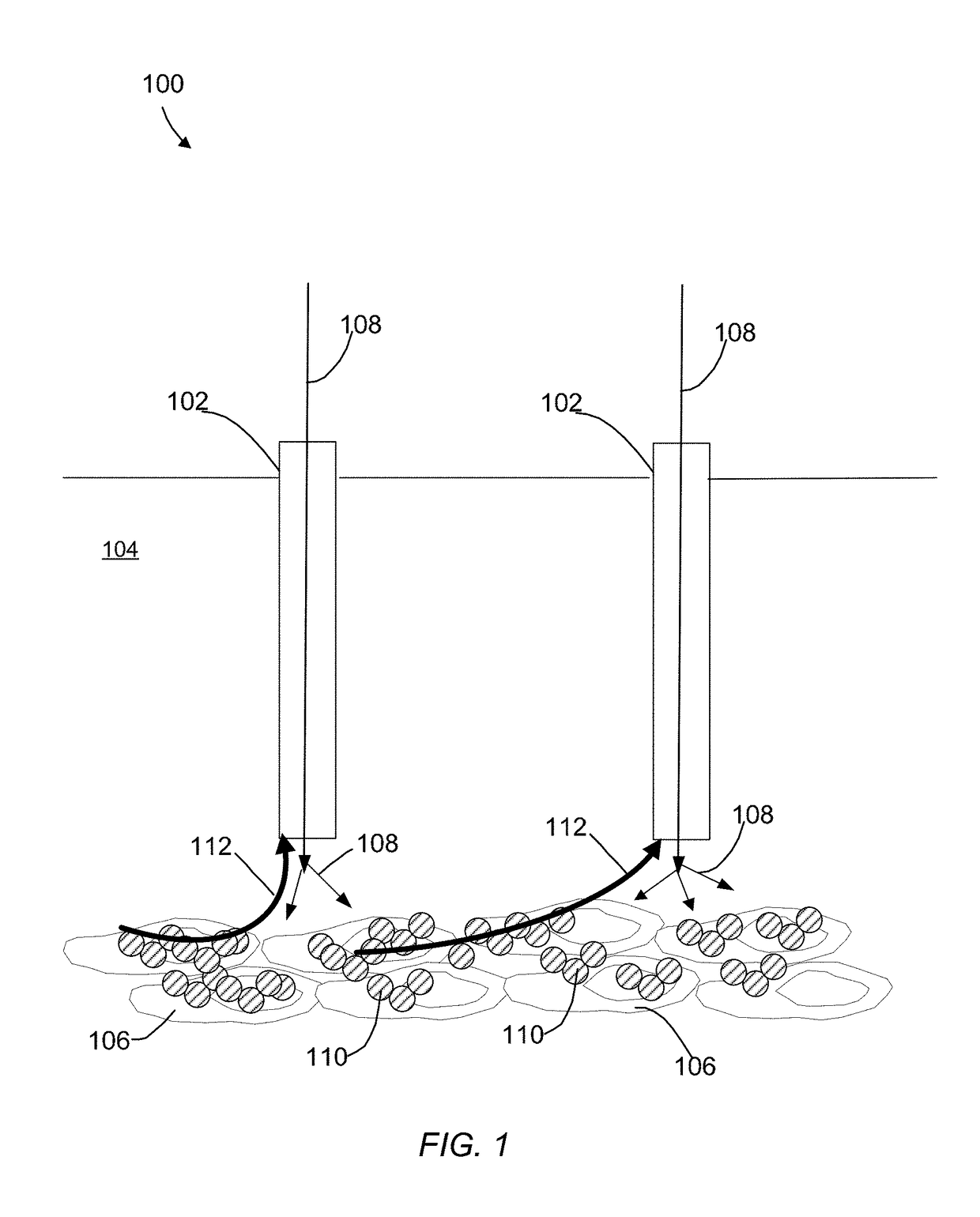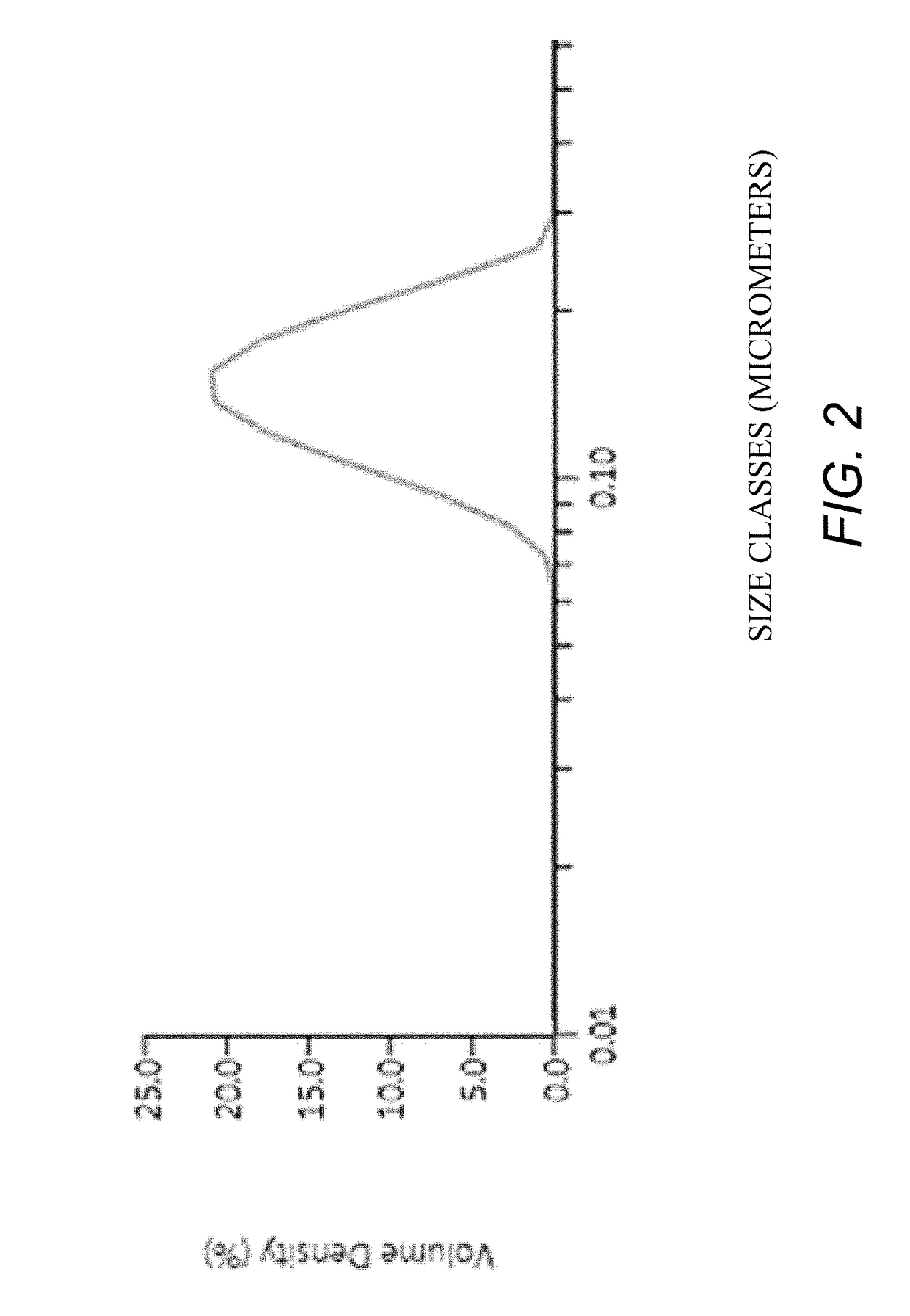Nanoparticle carrier platform and methods for controlled release of subterranean well treatment additives
- Summary
- Abstract
- Description
- Claims
- Application Information
AI Technical Summary
Benefits of technology
Problems solved by technology
Method used
Image
Examples
example 1
Nanoparticle Preparation
[0059]Nanoparticles according to the present invention can be prepared using a precipitation method.
[0060]Magnesium chloride (0.18 g, MgCl2, Sigma Aldrich® (U.S.A.)) and calcium chloride (0.18 g, CaCl2, Sigma Aldrich) were dissolved in deionized water (180 mL) to form a 0.1 wt. / vol. % by solution. The magnesium calcium chloride solution was heated to 90° C., and aluminum tri-sec-butoxide (25.4 g, Al(sec-BuOH)3, Sigma Aldrich® (U.S.A.)) was added to above Mg / Ca salt solution to form a 3 wt. % Al / Mg / Ca colloid suspension. The Al / Mg / Ca colloid suspension was stirred for an hour at 90° C., and then any volatile by-products (e.g., residual alkoxide and salts thereof) were evaporated by stirring the solution in an open container for approximately 3 hours at 90° C.
[0061]The pH of the Al / Mg / Ca colloid solution was adjusted to 4 by addition of nitric acid (0.4436 mL, 70%, Fisher Scientific, (U.S.A.)). At or around pH of 4, the aluminum / magnesium / calcium nanoparticles ...
example 2
Nanoparticle Characterization
[0062]Size and size distribution. Nanoparticle size and size distribution were determined using a laser diffraction particle size analyzer (Malvern Mastersizer 3000) and by TEM imaging. Table 1 lists the size in μmeters and % volume density obtained through particle size analysis. FIG. 2 depicts a graph of the size classes in μm versus volume density in percent (%). FIG. 3 depicts a TEM image of the SPCA loaded nanoparticles at a 100 nm scale. Arrow 301 points to the light gray uniform background area formed from the carbon tape that was used as a holder for the loaded nanoparticles during TEM imaging. Arrow 302 points to a large aggregate of nanoparticles, arrow 303 points to a small aggregate of nanoparticles or single nanoparticle, and arrow 304 points to the SPCA polymer surrounding the nanoparticles (darker material than background, but lighter than the nanoparticles.
TABLE 1Size (μm)% Volume Density≦0.0600.0680.270.0772.140.095.760.0110.380.1114.750...
example 3
Release Performance of Scale Inhibitor
[0068]Release performance was measured in reservoir material by injecting the nanoparticles from Example 1 or a comparative sample (SPCA alone (“SPCA”) into the core material and then flowing simulated produced water back through the same reservoir material.
[0069]The release rate was determined by the concentration of the loaded nanoparticles of the present invention or SPCA over time. FIG. 7 depicts a graph of SPCA and the loaded nanoparticles of the present invention concentration returns as translated to production days. Data line 700 is the loaded nanoparticles of the present invention and data line 702 is SPCA. From the data, it was determined that the loaded nanoparticles of the present invention provided controllable release of the additive over an extended period of time that was at least 5 times longer than the conventional additive.
PUM
| Property | Measurement | Unit |
|---|---|---|
| Temperature | aaaaa | aaaaa |
| Temperature | aaaaa | aaaaa |
| Time | aaaaa | aaaaa |
Abstract
Description
Claims
Application Information
 Login to View More
Login to View More - R&D
- Intellectual Property
- Life Sciences
- Materials
- Tech Scout
- Unparalleled Data Quality
- Higher Quality Content
- 60% Fewer Hallucinations
Browse by: Latest US Patents, China's latest patents, Technical Efficacy Thesaurus, Application Domain, Technology Topic, Popular Technical Reports.
© 2025 PatSnap. All rights reserved.Legal|Privacy policy|Modern Slavery Act Transparency Statement|Sitemap|About US| Contact US: help@patsnap.com



